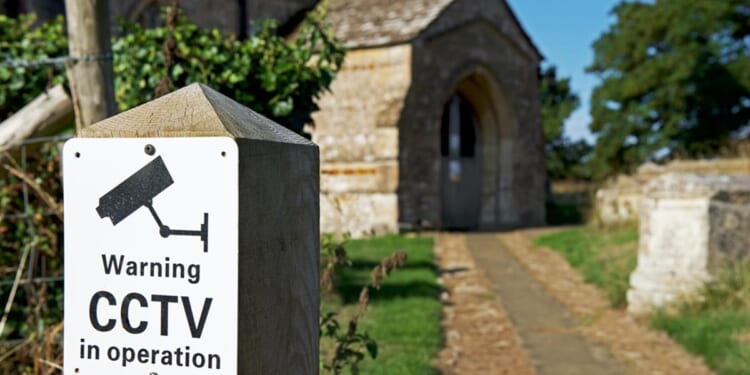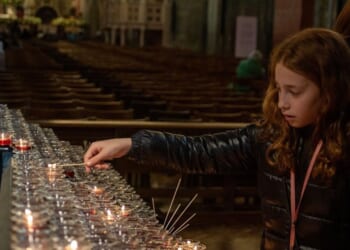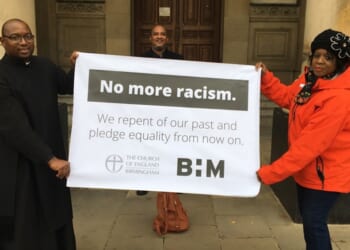CHURCH crime is nothing new. Years before Morrissey sang of “lifting some lead off the roof of the Holy Name Church” (“Vicar in a Tutu”, 1986), the Bishop of Digne in Victor Hugo’s 1862 Les Misérables was letting the escaped convict Jean Valjean get away with his silver candlesticks. Even the late Roger Scruton lamented his theft of a pair of crystal cruets in “Stealing from Churches” (Gentle Regrets, 2006).
But church crime rates — a criminal offence on church or other religious property — have been steadily rising. The Countryside Alliance’s (CA) latest survey on the problem presented stark findings: from 2022 to 2024, more than 9000 crimes were committed at churches, ranging from theft and vandalism to hate crime and general anti-social behaviour (News, 21 April).
To get the best picture it could, the CA sent Freedom of Information requests to the UK’s 45 police forces. The majority (about three-quarters) responded. The 9648 registered crimes equated to an average of eight church incidents each day for the three-year period. The CA began the exercise in 2019, looking back at crime rates from 2017. Although the data sets have varied, the anecdotal indications are that crime rates have gone up, and churches are increasingly seen as easy targets.
The director of external affairs at the CA, Mo Metcalf-Fisher, describes the assaults as “horrific attacks” on churches. “Thieves and criminals treat them as easy targets, brazenly stealing and causing criminal damage to these focal points of our communities. Churches and places of worship are the beating heart of many rural towns and villages. They are meant to be places of sanctity, solace, and refuge.
“We cannot allow these cherished places to continue to be unprotected against criminals,” he says. “It is vital that the public keep a watchful eye and report any issues to the police.” While “the picture may change from year to year”, he does not expect a fall in the number of crimes soon.
The organisation has long campaigned for the extension of the Government’s protective security for faith communities schemes, which have been running annually since 2016. Overseen by the Home Office, with the original aim of tackling hate crime, the schemes have made available sums of between £1.6 million and £2.4 million for protective security for the Jewish community, for mosques, and for what are listed as “places of worship (for all other faiths)”.
The Home Office says that, for security reasons, it does not not release the number of successful applications. “Since 2019/20, successful applicants aren’t directly given grant funding — rather, they are approved to receive security measures installed by our supplier,” a spokesperson said.
ST ALPHAGE’s, Burnt Oak, in north London, is one church that has been given the green light to improve its security. The Priest-in-Charge, the Revd Luke Demetri, credits a churchwarden who was keen to do something about issues with safety and anti-social behaviour. “These were not major crimes, but they were wearing,” Fr Demetri explains. “Things like drug use and break-ins.”
Online research uncovered the Home Office scheme, an enquiry was sent in, and three consultants then came to visit the parish. “They had a look around, asked lots of questions, then went away and submitted their report.”
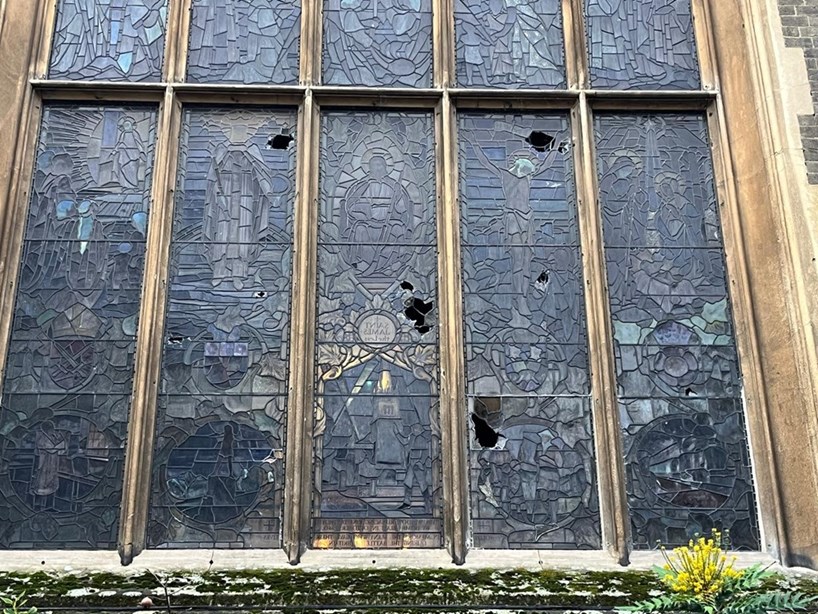 St James’s PaddingtonDamage done by vandals to the Te Deum window of St James’s, Sussex Gardens, in London
St James’s PaddingtonDamage done by vandals to the Te Deum window of St James’s, Sussex Gardens, in London
About three months later, the application was approved, and equipment estimated to be “of a value in the tens of thousands” will soon be installed, to include extra cameras, a new alarm system, and security gates to close off the area behind the church. Fr Demetri hopes that it will offer some peace of mind to users of the church area and improve its safety. The Home Office has not given a date for when the scheme will be open for applications again, but encourages signing up “to receive emails on our GOV.UK page as this will be updated as soon as the application window for the scheme opens”.
St James’s, Sussex Gardens, close to Paddington Station, can attest to the scheme’s benefits. The Revd Timothy Handley had become the new Vicar only two months earlier, when, in January 2024, he heard a smashing sound from the 19th-century east window during evening prayer. It was the fifth day in a row that rocks had been launched at the stained glass; this time, the police came, and an arrest was made. The culprit had been identified on the church’s CCTV system, which had been installed a year before with a Home Office grant when a previous visitor had smashed a statue inside.
St James’s maintains a policy of being open to the public. It was where Oscar and Constance Wilde were married, and, with a large railway terminus and hospital in one direction, and Hyde Park in the other, the church has a lot of footfall. “People come in to see the building, to sit and pray, or just experience something different for a while,” Fr Handley says. “All this has to be balanced, but it’s important to stay open. You don’t ever feel entirely safe. Yes, it is a risk, but most people are harmless.”
Their vandal served 14 months in prison on remand, and, when asked about the crime, said: “I hate Christianity.” On the day of the trial, he pleaded guilty, and was released on account of time served already. The £35,000 bill for the damage was, to the relief of the parish, covered by insurance, but further protective measures were needed. Grilles were added to the windows, with funds once again from the Home Office protection scheme.
This year, Parliament has enacted the Terrorism (Protection of Premises) Act 2025, also known as “Martyn’s Law”, to keep the public safe. The Government is working on guidelines for places of worship: its framework will apply to places of worship when more than 200 people are present, and will be of particular relevance to cathedrals.
Even given today’s lower church attendance figures, key events throughout the year — carol services, Christmas and Easter liturgies, weddings, funerals, memorial services, and ordinations — could easily mean a congregation of 200. The Home Office has clarified that this “standard tier” means “if you regularly have more than 200 people present at your church”. Exactly how regular that might be awaits further definition.
THE CA survey’s statistics found Kent to be the second worst area for church crimes: 655 were incidents recorded. The Priest-in-Charge of Christ Church, Chatham, in the diocese of Rochester, the Revd Andrea Leonard, calls her parish “a crime hotspot, a bit of a dodgy area”, which has high rates of drug-use. On the basis of local council rankings, it is among the four per cent most deprived locations in the UK.
She describes “a trauma” when two First World War memorial plaques were stolen from the church’s lychgate earlier this year (News, 30 May). They were later discovered in an Essex scrapyard, and seven men are now awaiting trial. The church has adjusted its security-camera positions and made the necessary reports.
 Countryside AllianceMo Metcalfe-Fisher of the CA
Countryside AllianceMo Metcalfe-Fisher of the CA
Despite the upset, the parish was determined to be positive. An online funding campaign, the church’s insurers, Ecclesiastical Insurance, and the BBC’s Repair Shop all came to the rescue. The TV programme showing the safe restoration of the plaques to the parish will be broadcast before Christmas. It includes a ceremony with the “Last Post” and a two-minute silence.
“Our one question is whether we keep them outside as a public witness to the 163 fallen combatants, or now have them securely inside, and they don’t really ‘belong’ to the church in that way,” she says.
Another challenge is the faculty process, which she describes as “the most outdated system of the C of E. Honestly, the worst thing: before we could breathe or do anything, we had to get a faculty”.
The system is designed to provide a Church-run autonomous system of planning controls for churches and churchyards, granting authorisation where required through archdeacons and the diocesan consistory court for anything related to consecrated land and buildings. At its best, it provides an assurance that whatever work is carried out on church buildings is appropriate and done properly, although some parishes describe it as cumbersome and onerous at times. (When it is criticised, it is often suggested that to come under the planning oversight of local government would be worse.)
For the people at Paddington, it was “relatively straightforward”. They had a culprit, evidence, and shattered fragments. Their main issue, Fr Handley said, was dealing with the insurers’ wanting to treat the separate incidents as different claims — each with its own excess to pay — and then having to find an “accredited conservator” whom the diocesan advisory committee would be happy to approve to undertake the restoration work. “We lost six months of our time on that,” Fr Handley recalls, even though the faculty process did not cause any problems. “The diocese of London was really helpful.”
ESSEX POLICE responded in full to the CA survey: 500 had been crimes recorded at churches in the county over the period (213 thefts, 159 cases of criminal damage, and 128 cases of violence, while two crimes related to the theft of lead from church roofs). DCI Clayton Ford is the head of the assessment and investigation centre with Essex Police.
“Historic sites and buildings, including churches, are central to local identity, pride, and cohesion,” he says. “Unfortunately, in many cases, due to their isolated locations, some churches are vulnerable to theft and criminal damage and can attract anti-social behaviour [ASB].”
He explains that “where damage is reported at churches, it is often doors and windows that are targeted, either as ASB, or to gain entry, or attempt to gain entry. Graffiti from ASB is also reported at some churches, and we know that removal of graffiti, if not done correctly, can cause even more damage.”
Vandalism and anti-social behaviour have ben issues for the Revd Kate Wharton in the churches where she has ministered in the north-west. Her Liverpool parishes in Everton and Roby have had graffiti, smashed gravestones in the churchyard, broken windows — caused by sticks pushed through the grille — and theft. She describes the incidents as “low-level”, and says that they largely relate to an “obvious lack of youth provision which leads kids to misbehave”. The church does have a youth group, she acknowledges, “but only one day per week”.
On one occasion, some young people stole money that they had found in church and used it to buy “insignificant items”. She went to their homes and used it as an exercise in forgiveness and accountability, with the co-operation of their families, who were “horrified” by the theft. “They all had to save up their pocket money and pay back what they had stolen,” Ms Wharton says. “It worked. All the money came back. They didn’t do it again.”
The example of two adults who came into church one Sunday, and casually walked off with money that they had lifted from the collection plate was less successful. “A couple of us followed them down the road — having seen what they’d done — and confronted them. But they ran off.”
She is sanguine about such crimes and their causes as being symptomatic of depressed areas and “not isolated incidents” in any way. “People often don’t think about the implications of what they do, and there’s no obvious reason for it in the first place. More often than not, it’s just kids messing around.”
This chimes with the vandalism at St James’s, Leyland, this year, when nearly 40 gravestones and the exterior of the Lancashire church were sprayed with obscene graffiti. The vandalism was discovered on the morning of Good Friday, and Lancashire Police designated it a hate crime. The Vicar, the Revd Marc Wolverson, says that he had seen casual crime there before, but “nothing this serious. . . I pray that [the culprits] come to realise that behaving in such a hurtful and harmful way towards the church and the community is not going to bring them any fulfilment.”
STATISTICALLY, theft continues to be the main headache for churches. Earlier this year, Ecclesiastical Insurance reported how the “worrying new trend of silver theft from churches has seen irreplaceable silverware worth over £500,000 stolen across the UK over the last 12 months” (News, 13 February). The head of church operations at Ecclesiastical, Mark Cowdell, describes theft as “heartbreaking”. He says: “It has a huge impact.”
He has not seen any significant rise in claims, and describes the volume as a “stable, steady trickle — neither increasing nor decreasing” — although he concedes that not all churches report thefts or use the insurance system.
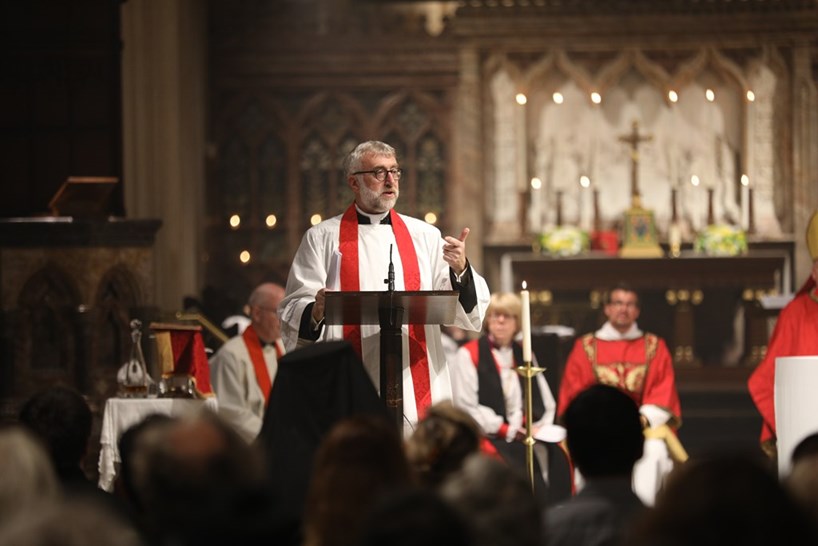 St James’s Paddington The Vicar of St James’s, Sussex Gardens, the Revd Timothy Handley
St James’s Paddington The Vicar of St James’s, Sussex Gardens, the Revd Timothy Handley
Claims for roof-metal thefts have dropped off “because the values of lead and copper have gone down, and churches are better protected”. Instead, most of the thefts reported to Ecclesiastical now are silver items, Mr Cowdell says. “They are often historically important, can have sentimental value as they’ve been donated, and are irreplaceable.” He suggests that the trend is “not at epidemic-type levels”, but is part of the move towards more opportunistic thefts. This includes the loss of cash donations and collections, brass lecterns, silver, and electronic devices.
The silver is a particular problem, “because precious metals are often melted down, which makes recovery of these items tricky”. Last summer, Sherborne Abbey suffered the theft of “only solid silver: a processional cross, two virges, and a bishop’s crosier” (News, 16 August 2024). The Team Rector was of the view that the items, valued at £90,000, were seen when the burglars had “cased the joint beforehand” during the day, when the church was open, before returning at night to break in.
Mr Cowdley’s advice is to keep things locked away when not in use. Getting used to doing this “is a good discipline to have”, he says, even when items are in display cases. He notes that some policies allow for items to be stored at home by clergy, and points to the closure of banks as a dilemma, because many rural parishes used local bank vaults for safe-deposit purposes, and those are no longer available.
He offers practical advice: “Good housekeeping is key. Document all the items you have, with photos, and keep all the details in an archive. Photos of items in situ are especially helpful. Keep the log up to date. Also, undertake forensic marking where possible.” The Ecclesiastical risk-management team will assist in this exercise, he says, and it regularly sends out packs to parishes for education and awareness. They can also help with access to specialist supply chains when specific advice and services are required.
THESE security concerns apply across other sectors, too, and to buildings with similar profiles to churches. DCI Ford points to “a committed and effective partnership” between the Police and Historic England, OPAL (the national intelligence unit focused on serious organised acquisitive crime), the CPS, and “hundreds of volunteers and passionate supporters of our country’s heritage assets, and who own and care for our historic buildings, including our churches”.
The National Police Chiefs’ Council is a member of the Alliance to Reduce Crime Against Heritage, a voluntary national network that takes forward initiatives to tackle heritage crime and galvanise local action as part of the Heritage Crime Programme — another example of joined-up working that should benefit churches.
Crime-prevention advice is available through individual police-force websites, he says, but also in some detail on the Historic England website. Heritage Watch schemes enable the public to report and provide information on crime, suspicious behaviour, and “damage they observe at heritage assets in their community or while out and about”.
“A busy church is often a secure church,” Mr Cowdell says. “The archetypal ‘nosy neighbour’ can be a great community asset.” He also advises being alert to seasonal changes. “With the clocks about to change, check the security measures in place — especially bulbs in security lights and connections for floodlighting.” Vigilance is the consistent watchword, along with being prepared for various eventualities, even the unexpected.
Items can come back. Last year, an altar cross that had been stolen 30 years ago from All Saints’, North Cerney, was discovered on the retired verger’s doorstep early one morning (News, 6 December 2024). It had been presented to the Gloucestershire church by a faithful parishioner who had since died, and its mysterious return delighted her family. Although a cause for celebration, this event was still a rare one. Items are not usually recovered.
Christian hope recognises the broader canvas. In Les Misérables, Valjean never forgot the bishop’s kindness, and turned his life around for the better. Scruton became a committed churchwarden and village organist. Robbery and redemption are as connected as locks and keys.
Practical advice and tips for church security
- Keep a register of valuable items, maintain it regularly, and include photos.
- Hold a log of who has keys to church buildings, and be organised with the keyholders.
- Identify a good local locksmith in advance, and have their details to hand.
- “Have as much security in place as you can, have everything insured. Items can be valuable, old, and treasured, but remember it’s only stuff. The important thing is that people are safe” — the Revd Andrea Leonard.
- “Work with professionals who can identify where you may have vulnerabilities. Security consultants can come and give an informed view. The report itself which went to the Home Office was hugely helpful, and gave us a number of pointers” — the Revd Luke Demetri.
- Ecclesiastical Insurance:
- Consider installing electronic security protections in the church, such as intruder alarms or remote video-surveillance systems, linked to a monitoring centre.
- Make sure any safes are high-quality and modern with a Euro rating between 0 and 7, and that they are permanently fixed to a wall or floor to make them more difficult to remove.
- Ensure that items are recorded in the church inventory and are security marked using SmartWater, which will assist recovery if stolen.
- Keep portable valuable items in a secure area — the safe where practical, or a locked vestry or similar area when not in use.
- Where this is not possible, consider keeping items at the home of a church member (which would be covered by Ecclesiastical).
- Encourage the local community to be vigilant and report any suspicious activity, as thieves may make a reconnaissance before a theft.
- Crimes and ASB can be reported in three ways:
- 999 in an emergency;
- 101 when a crime or suspicious has already taken place;
- 0800 555 111 for anonymous reporting via CrimeStoppers.
- ASB Awareness Week takes place at the beginning of July, and can be a way for parishes to connect with the local community and police force.
- For the Home Office protection scheme, visit: gov.uk
- Consider installing electronic security protections in the church, such as intruder alarms or remote video-surveillance systems, linked to a monitoring centre.
- Make sure any safes are high-quality and modern with a Euro rating between 0 and 7, and that they are permanently fixed to a wall or floor to make them more difficult to remove.
- Ensure that items are recorded in the church inventory and are security marked using SmartWater, which will assist recovery if stolen.
- Keep portable valuable items in a secure area — the safe where practical, or a locked vestry or similar area when not in use.
- Where this is not possible, consider keeping items at the home of a church member (which would be covered by Ecclesiastical).
- Encourage the local community to be vigilant and report any suspicious activity, as thieves may make a reconnaissance before a theft.
- 999 in an emergency;
- 101 when a crime or suspicious has already taken place;
- 0800 555 111 for anonymous reporting via CrimeStoppers.

